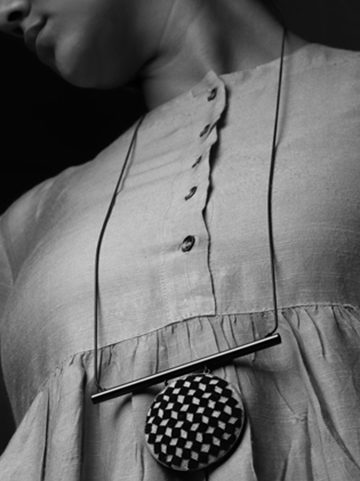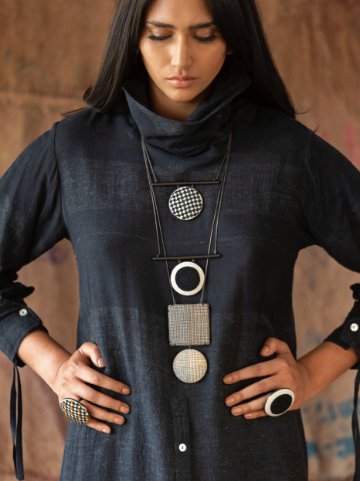


To optimize and ensure a bright future, the first trial weaves which were distributed to the designers were developed on a power loom which ensured an industrial process rather than taking the traditional route of hand-woven, which is not strong enough to withstand the demands of modern daily life. The brief submitted to the designers is a logical consequence: to visualize the future of fashion design, and the way they feel India and the world will be in the 21st century and beyond.
Ramie Collection created by 15 Indian Designers is currently exhibited at The Museum for Lace and Fashion in Calais, France.

AKIHI by Srishti Arora
Akihi’s collection combines bold geometry in earthy colors with subtle embellishment, boasting a timeless aesthetic. Ramie acts as the canvas on which Srishti Arora designs a medley of textures using metal wires and threads twined together with intricate stitches, which is then mounted on a plated brass frame, transforming a piece of fabric into jewellery.

AKIHI by Srishti Arora

Akihi’s collection combines bold geometry in earthy colors with subtle embellishment, boasting a timeless aesthetic. Ramie acts as the canvas on which Srishti Arora designs a medley of textures using metal wires and threads twined together with intricate stitches, which is then mounted on a plated brass frame, transforming a piece of fabric into jewellery.


ATSU by Atsu Sekhose
Inspired by the classic 1940's 'New Look' silhouette. Atsu Sekhose creates a graphic modern pantsuit with the Meghalaya ramie fabric. Sekhose has selected a contrasting cream and black colour combination to highlight the natural texture of the cloth. This garment with its sharp tailoring and elaborate bow details dovetails perfectly with Atsu's aesthetic.

AKIHI by Srishti Arora

Inspired by the classic 1940’s ‘New Look’ silhouette. Atsu Sekhose creates a graphic modern pantsuit with the Meghalaya ramie fabric. Sekhose has selected a contrasting cream and black colour combination to highlight the natural texture of the cloth. This garment with its sharp tailoring and elaborate bow details dovetails perfectly with Atsu’s aesthetic.


BODICE by Ruchika Sachdeva
India, is vast and diverse with myriad cul tures, religions, languages, and cuisines. An eternal paradox of chaos and order. This piece made from the natural fiber Ramie encapsulates the Bodice philosophy of comfortable yet structured pieces. Inspira tion is drawn from twentieth-century artist Nasreen Mohammedi's rhythmic use of line to express the principles of order that underline the natural world around us.

BODICE by Ruchika Sachdeva

India, is vast and diverse with myriad cul tures, religions, languages, and cuisines. An eternal paradox of chaos and order. This piece made from the natural fiber Ramie encapsulates the Bodice philosophy of comfortable yet structured pieces. Inspira tion is drawn from twentieth-century artist Nasreen Mohammedi’s rhythmic use of line to express the principles of order that underline the natural world around us.


DANIEL SYIEM by Daniel ‘Nongjop’ Syiem
The garment draws inspiration from the tribal princess of Meghalaya. The youngest daughter who is bound to tradition while trying to manoeuver herself into the moern world, balancing the life of a tribalroyal amidst the evolving changing modern world, hence the title “Urban Princess”. The garment utilizes tribal and cultural features embedded within a modern outlook.

DANIEL SYIEM by Daniel ‘Nongjop’ Syiem

The garment draws inspiration from the tribal princess of Meghalaya. The youngest daughter who is bound to tradition while trying to manoeuver herself into the moern world, balancing the life of a tribalroyal amidst the evolving changing modern world, hence the title “Urban Princess”. The garment utilizes tribal and cultural features embedded within a modern outlook.


DRVV by Dhruv Kapur
I have contemplated this for a long time, and the imposition of a specific body type by society, then propagated through fashion, is inherently reflective of a paternistic system. I have tried to bring to notice the ridiculousness of such expectations by exaggerating the expectations themselves & imposing a much harsher silhouette onto the contemporary woman’s frame, as a warning for what might come.

DRVV by Dhruv Kapur

I have contemplated this for a long time, and the imposition of a specific body type by society, then propagated through fashion, is inherently reflective of a paternistic system. I have tried to bring to notice the
ridiculousness of such expectations by exaggerating the expectations themselves & imposing a much harsher silhouette onto the contemporary woman’s frame, as a
warning for what might come.


KALEEKAL by Alan Alexander
A study in deconstruction & reconstruction of wardrobe staples. What constitutes a garment when its aesthetic and functional values are stripped away? An experiment on abstraction of a garment, this is a representation of how a garment looks on a cutting table before the final assembly. A sheer panel of fabric forms the background and the fractured tailored pieces are appliquéd onto this base thus reconstructing a flat, 2-dimensional recreation/ semblance of a garment.

KALEEKAL by Alan Alexander

A study in deconstruction & reconstruction of wardrobe staples. What constitutes a garment when its aesthetic and functional values are stripped away? An experiment
on abstraction of a garment, this is a representation of how a garment looks on a cutting table before the final assembly. A sheer panel of fabric forms the background
and the fractured tailored pieces are appliquéd onto this base thus reconstructing a flat, 2-dimensional recreation/ semblance of a garment.


KISHMISH by Rekha Bhatia & Nikki Kalia
While working with ramie we have attempted to understand it’s nature. We believe, if the process of making a garment is done slowly, thoughtfully & with kindness, one can feel it when one wears that garment. The journey is as important as the result. Ramie is a very unique & special fabric. It fits with the Kishmish philosophy of moving towards sustainable fashion & a more conscious world.

KISHMISH by Rekha Bhatia & Nikki Kalia

While working with ramie we have attempted to understand it’s nature. We believe, if the process of making a garment is done slowly, thoughtfully & with kindness, one can feel it when one wears that garment.
The journey is as important as the result. Ramie is a very unique & special fabric. It fits with the Kishmish philosophy of moving towards sustainable fashion & a more conscious world.ridiculousness of such expectations by exaggerating the expectations themselves & imposing a much harsher silhouette onto the contemporary woman’s frame, as a
warning for what might come.


LECOANET HEMANT by Hemant Sagar & Didier Lecoanet
A personal vision of tribal Meghalaya’s journey towards embracing its newest material, Ramie: An ensemble comprising of an oversized protective cape of mineral and animal-inspired ruffled ecru/black and white cotton inlays. Worn over a high-waisted black-on-black skirt with ‘efilloché’ (strips) surface embellishments; accessorized with a tribal necklace assembled from raw ramie fibre and abstract-shaped pieces of coral and amber.

LECOANET HEMANT by Hemant Sagar & Didier Lecoanet

A personal vision of tribal Meghalaya’s journey towards embracing its newest material, Ramie: An ensemble comprising of an oversized protective cape of mineral and animal-inspired ruffled ecru/black and white cotton inlays. Worn over a high-waisted black-on-black skirt with ‘efilloché’ (strips) surface embellishments; accessorized with a tribal necklace assembled from raw ramie fibre and abstract-shaped pieces of coral and amber.


P.E.L.L.A. by Priyanka Ella Lorena Lama
The form has been crafted using zero waste pattern-making and relief- work technique and requires minimum of measurement and sewing making a CELLA. ‘Cella’ are the designs which have been developed from a single block of fabric without creating waste. The cloth is hand stitched using Kantha/Shashiko running stiches and are painstakingly hand rolled and blind hemmed to achieve a boundaryless design.The story weaves together in hues of creams to encapsulate the essence of handwoven and hand crafted Ramie beckoning you to get close, touch and relate.

P.E.L.L.A. by Priyanka Ella Lorena Lama

The form has been crafted using zero waste
pattern-making and relief- work technique and requires minimum of measurement and sewing making a CELLA. ‘Cella’ are the designs which have been developed from a single block of fabric without creating waste. The cloth is hand stitched using Kantha/Shashiko running stiches and are painstakingly hand rolled and blind hemmed to achieve a boundaryless design.The story weaves together in hues of creams to encapsulate the essence of handwoven and hand crafted Ramie beckoning you to get close, touch and relate.


Payal Khandwala
“My approach to designing this ensemble, woven from the ramie fiber was quite straightforward. I’m always looking for handwoven textiles that I can integrate into our collections and I thought it best to use the textiles to make a garment the way I would imagine it – in our colour palette and with our construction details.The idea was to keep the design simple, so the textile could take centre stage.”

Payal Khandwala

“My approach to designing this ensemble, woven from the ramie fiber was quite straightforward. I’m always looking for handwoven textiles that I can integrate into
our collections and I thought it best to use the textiles to make a garment the way I would imagine it – in our colour palette and with our construction details.The idea was to keep the design simple, so the textile could take centre stage.”


Peachoo
She has embraced the core essence of various eclectic sensibilities and intuitively incorporated them all into a single culture. Her creation is a ‘cache poussière’ which is a cross between a trench coat and a dress. This meaningful garment is made entirely out of Ramie and the Japanese Crane embellishment symbolises the poignant message of travelling from one place to another. It is a multicultural statement encompassing a deeply personal interpretation.

Peachoo

She has embraced the core essence of various eclectic sensibilities and intuitively incorporated them all into a single culture. Her creation is a ‘cache poussière’ which is a cross between a trench coat and a dress.
This meaningful garment is made entirely out of Ramie and the Japanese Crane embellishment symbolises the poignant message of travelling from one place to another. It is a multicultural statement encompassing a deeply personal interpretation.


péro by Aneeth Arora
The concept behind the look was to create a multi panel garment, bringing together the rawness through di erent weights , textures and natural shades of woven ramie fabrics creating a look that would show how di erent fabrics work when put together.The look is not about an age group or a season, it is about a mindset, a willingness to incorporate nature and it’s natural ways. The most innovative part of the project was to discover how to incorporate the ramie fibre in our authentic péro style.

péro by Aneeth Arora

The concept behind the look was to create a multi panel garment, bringing together the rawness through di erent weights , textures and natural shades of woven ramie fabrics creating a look that would show how di erent fabrics work when put together.The look is not
about an age group or a season, it is about a mindset, a willingness to incorporate nature and it’s natural ways. The most innovative part of the project was to discover how to incorporate the ramie fibre in our authentic péro style.


Rajesh Pratap Singh
The idea is to keep the Ramie fabric as pure as possible and keep the silhouette and colour true to the fabrics natural state. To explore the possibilities with this new fabric / yarn initiative and to experiment with the opposites: The jacket is in ramie and a silk blend. It has been made using both tailoring and drape so that it accentuates and reveals the versatility of the fabric. The cowl shirt and the pleated skirt resonate the same idea of draping and tailoring and have been block printed subsequently at the garment stage.

Rajesh Pratap Singh

The idea is to keep the Ramie fabric as pure as possible and keep the silhouette and colour true to the fabrics natural state. To explore the possibilities with this new fabric / yarn initiative and to experiment with the opposites: The jacket is in ramie and a silk blend. It has been made using both tailoring and drape so that it accentuates and reveals the versatility of the fabric. The cowl shirt and the pleated skirt resonate the same idea of draping and tailoring and have been block
printed subsequently at the garment stage.


Saviojon by Savio Jon Fernandes
“My design philosophy has always been a nod towards the classic shirt, which is to me: a most simple and complex construction all at once. My fascination with the shirt has led me to explore variations of the t-shirt, tunic and shirt dress whether I am constructing or deconstructing them, or elevating them to some kind of theatrical status. For this exhibition, I traced the progression of the humble shirt.”

Saviojon by Savio Jon Fernandes

“My design philosophy has always been a nod towards the classic shirt, which is to me: a most simple and complex construction all at once. My fascination with the shirt has led me to explore variations of the t-shirt, tunic and shirt dress whether I am constructing or deconstructing them, or elevating them to some kind of theatrical status. For this exhibition, I traced the progression of the humble shirt.”


HUEMN by Shyma Shetty & Pranav Misra
India is land of paradoxes. A melting pot of ancient cultures that has simmered for thousands of years to create society, as we know it today. Just below the surface, a young and dynamic republic bubbles, threatening to spill over. Within this project, we explore the maiden journey of one of the oldest textile fibers in the world through one of the oldest civilizations of the world, effectively throwing open the windows to life on Indian streets in 2018. If you look carefully, you will find our protagonist- a square piece of fabric.

HUEMN by Shyma Shetty & Pranav Misra

India is land of paradoxes. A melting pot of ancient cultures that has simmered for thousands of years to create society, as we know it today. Just below the surface, a young and dynamic republic bubbles, threatening to spill over. Within this project, we explore the maiden journey of one of the oldest textile fibers in the world through one of the oldest civilizations of the world, effectively throwing open the windows to life on Indian streets in 2018. If you look carefully, you will find our protagonist- a square piece of fabric.


